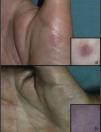Circumscribed palmar hypokeratosis (CPH) is a skin disorder characterized by a well-circumscribed, depressed, reddish area with a scaly border. Lesions tend to be solitary and are typically located on the thenar and hypothenar eminences of the palms. There are no established treatments. We present 2 cases of CPH treated with cryotherapy on the thenar eminence of the palms of 2 patients.
The first patient was a 60-year-old woman with no relevant medical history who presented with a well-circumscribed, erythematous, depressed, lesion with a stair-like border on the thenar eminence of the right hand (Fig. 1A). The lesion was not hard to the touch and had appeared a year earlier. It had been treated with topical corticosteroids but shown no improvement. The second patient was a 66-year-old woman, also with no relevant past history, who presented with a similar plaque of 7 years’ duration on the thenar eminence of the right palm (Fig. 2A). The lesion had grown progressively over the years. Both patients denied triggers.
Dermoscopy in both cases revealed an erythematous-pink, round, central area with white spots and a stair-like border with desquamation. In both cases, histologic examination showed depression of the epidermis with a sharp stair-like border between the normal and affected skin (Fig. 3). The depressed epidermis showed hypokeratosis and hypogranulosis compared with the surrounding skin. A cornoid lamella was not observed in serial slices. There were also no signs of atypia. The histologic findings were consistent with a diagnosis of CPH. CPH was first described in 2002.1 It clinically presents as a round, erythematous, circumscribed, asymptomatic, generally solitary, lesion on the thenar or hypothenar eminences of the palms, although plantar lesions have been reported. The condition usually affects women aged between 51 and 70 years, although there has been a report of a congenital case.2,3 Numerous hypotheses have been proposed to explain the etiology and pathogenesis of CPH, including human papillomavirus infection, repeated trauma, or a defect in keratinization in the affected area. This last hypothesis is the most widely accepted one.
The defect in keratinization was originally thought to be due to a localized epidermal malformation,1 but it is currently thought that it might be due to clonal expansion of altered keratinocytes, as there have been reports of slow-growing lesions,3–5 like the one in our second patient.
The differential diagnosis should include porokeratosis of Mibelli, Bowen disease, the base of a blister in the erosion stage, or more rarely, pitted keratolysis.3
CPH is considered to be a benign disease, but there has been a case in which histologic changes associated with actinic keratosis were observed, suggesting possible malignant transformation.6 Follow-up is therefore recommended.
There are no established treatments. Surgical excision, photodynamic therapy, topical corticosteroids, 5-fluorouracil, and topical calcipotriol have all been used, but with highly variable results.3 There has also been a case of CPH that had resolved completely by the 2-month visit following treatment with two 15-second cycles of liquid nitrogen cryotherapy.7 As cryotherapy is affordable, has few adverse effects, and is readily available in routine practice, we decided to use the same cryotherapy regimen in our 2 patients. In the first patient the lesion resolved completely (Fig. 1B) and in the second patient, it also cleared, but left a scar-like papular area (Fig. 2B). The rationale for the use of cryotherapy is the existence of altered keratinocytes undergoing clonal expansion that would be destroyed and replaced by adjacent healthy keratinocytes, thereby resolving the defect.
Finally, and in agreement with Boffa and Degaetano,7 we believe that cryotherapy could be considered a first-line, safe, accessible, affordable, and effective treatment for CPH.
Conflicts of InterestThe authors declare that they have no conflicts of interest.
Please cite this article as: Boix-Vilanova J, Montis-Palos MC, Giacaman A, Antón-Valentí E. Hipoqueratosis circunscrita palmar: tratamiento mediante crioterapia. Actas Dermosifiliogr. 2019;110:174–176.












